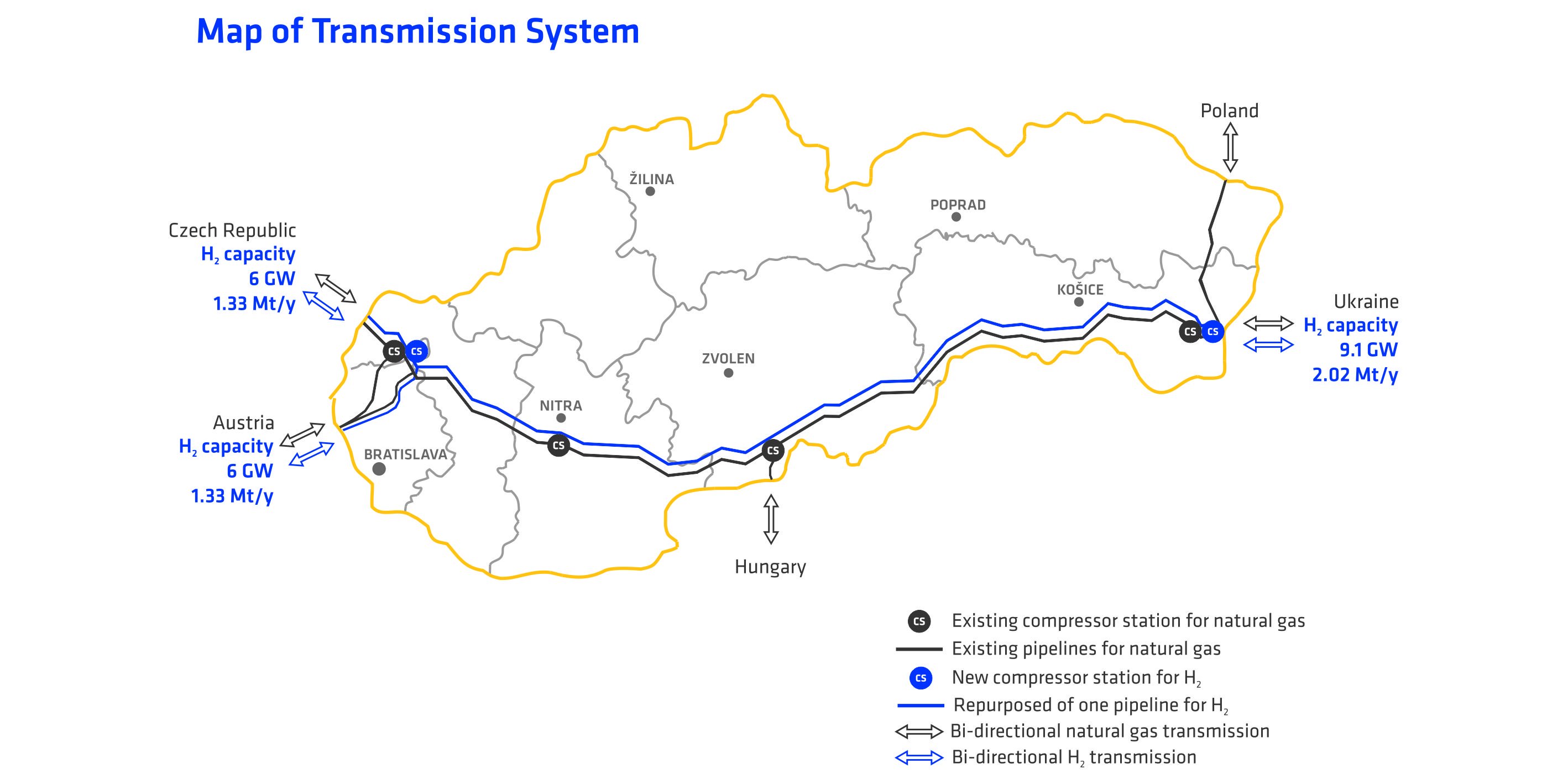Energy Transformation Projects

EUSTREAM is fully aware of its social responsibility regarding climate change and is committed to contributing to its mitigation. EUSTREAM sees its role in addressing this global climate issue primarily through a proactive approach to interregional needs in the transmission of low-carbon gases when there is relevant market demand. The implementation of development projects with an environmental focus will be a necessary step towards fulfilling the European Union's environmental goals.
EUSTREAM plans to carry out a series of projects in the coming years, aimed at transforming the energy transmission network. These projects can be summarized in the following categories:
- Reduction of Methane Emissions: The objective of the projects in this category is to reduce methane emissions released into the atmosphere during the operation of the transmission network, thereby further mitigating the negative environmental impact. These projects in this category will include solutions focused on monitoring, quantifying, and minimising methane emissions.
- Enhancing Energy Efficiency of the Transmission Network: Projects in this category aim to implement systems that improve the energy efficiency of the transmission network, such as utilizing the secondary energy potential generated during natural gas transmission. In the context of EUSTREAM, this energy potential is mainly found at natural gas regulating stations and in the waste heat of operating turbo machinery.
- Transport of Natural Gas Mixed with Hydrogen: The projects under this category will enable the transmission of permissible concentrations of hydrogen blended with natural gas within the Slovak gas transmission network. Transporting natural gas with a hydrogen blend will help reduce the negative environmental impact of fossil fuels and meet the European Union's energy and environmental goals.
- Transport of Pure Hydrogen: EUSTREAM has joined several hydrogen initiatives in Central Europe, and the company's transmission system is set to become an integral part of the European Hydrogen Backbone, transporting significant volumes of hydrogen through all cross-border connection points of the transmission network. The EU’s energy transformation and the development of electromobility will require the import of large amounts of energy from outside the EU. It is anticipated that these locations will include North Africa, Ukraine, the Balkans, and potentially the Middle East. For this reason, EUSTREAM is working on various projects that will enable the formation of corridors according to current demand. Potential increases in hydrogen transport capacity will be ensured by new compressor stations equipped with electrically driven compressors. The transformation will require substantial investment, primarily in replacing or modifying unsuitable system components and constructing new hydrogen-specific compressor stations.
Transport of Pure Hydrogen
A key project for the company in this category is the Slovak Hydrogen Backbone (SHB) project. SHB is part of the latest list of Projects of Common Interest (PCI) under the designation 10.4 - A general corridor for the transmission of hydrogen from Ukraine to Slovakia, the Czech Republic, Austria, and Germany.
Project Objective:
To repurpose one of the existing gas pipelines connecting Ukraine in the east with the Austrian and Czech transmission networks in the west. This will create a cost-effective means of transporting significant volumes of 100% hydrogen from potential major green hydrogen production and storage hubs (North Africa, the Balkans, Ukraine) to consumption sites in Europe, particularly Germany. The project involves the construction of two new compressor stations and the repurposing of a 500 km existing pipeline for hydrogen transport with a capacity of up to 9.1 GW (2.02 Mt/year). Planned operation is expected post-2030.
SHB Project – A Key Component of Many Hydrogens Initiatives
Thanks to the SHB project, EUSTREAM is a member of several hydrogen initiatives aimed at connecting hydrogen production centres with demand hubs in various parts of the EU and beyond through new connections and the repurposing of existing pipelines (for more information, visit the initiatives’ websites):
- European Hydrogen Backbone
- European Clean Hydrogen Alliance
- H2EU+Store
- Central European Hydrogen Corridor
- SunsHyne Corridor
- EASTGATEH2V (an initiative of the Košice Self-Governing Region for the production, transport, and utilization of hydrogen in Slovakia);
- South-East European Hydrogen Corridor (SEEHyC).
The project, under the name Hydrogen Infrastructure – Transmission Repurpose (H2I-TR), has been approved for state aid by the European Commission, which, in February 2024, endorsed the third list of Important Projects of Common European Interest (IPCEI) in the field of hydrogen technologies. EUSTREAM's H2I-TR project has become part of this package of projects under the joint name IPCEI "Hy2Infra," along with 32 other projects from 7 EU member states.
Benefits of the Project:
- Strengthening Supply Security and Diversification of Energy Sources: Access to new renewable sources within and outside Europe.
- Improving Hydrogen Availability at a Favourable Price and Creating Conditions for Further Development of the Hydrogen Network in the Central European Region and in Slovakia: The aim is to make the Slovak hydrogen transmission network a crossroads for hydrogen transport in the Central European region, making Slovakia a key pillar for hydrogen transport, enabling flows from North Africa, the Balkans, and Ukraine (important for the recovery of Ukraine) to the EU.
- Safe and Sustainable Transport of Hydrogen over Long Distances or Its Import into Slovakia: Expected to have a positive impact on the unit price of hydrogen.
- Reducing Greenhouse Gas Emissions and Air Pollutants, and Fulfilling Slovakia's Decarbonisation Goals: Transition from natural gas or grey hydrogen, produced from natural gas, to green hydrogen, decarbonisation of Slovak industry, energy, and transport sectors.
- Utilizing Existing Pipelines by Repurposing Them for Hydrogen Transport: This is a much more efficient approach compared to building new pipelines, as it avoids costly investments in new infrastructure.
- Accelerating the Development of the Hydrogen Market and Creating New Jobs: Strengthening the development of hydrogen valleys in Slovakia (such as EASTGATEH2V) will support economic growth in many regions of Slovakia by creating new opportunities for businesses involved in hydrogen production, distribution, and utilisation. Hydrogen valleys will be a positive impetus for the adoption of hydrogen technologies and support for innovation.

